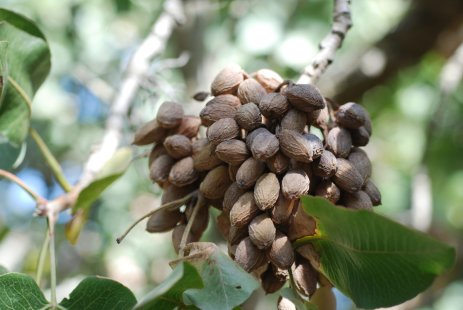
If you also suffer from Stigmatomycosis disease, Do not miss this article.
Symptoms of pistachio Stigmatomycosis
Due to the attack of the disease, the pistachio fruits are apparently healthy, but there is no kernel, or the kernel has grown a little and turns brown. The kernel may be deformed and dry, and necrotic spots may appear on it .
Sometimes, the fruit is apparently healthy, but in the kernel of infected unripe fruits, a viscous and colorless substance with a tendency to white is observed between the seed coat and the edges of the kernel.
This substance is white and relatively hard at the stage when the fruit is fully developed, and because of the presence of this viscous substance, it is white, which is why the disease is called Stigmatomycosis.
The causative agent of pistachio Stigmatomycosis
The causative agent of Stigmatomycosis is a fungus called Nematospora coryli and belongs to the Spermophthoraceae family. If the viscous and white substance of the infected pistachio kernel is examined under a microscope, a mixture of two types of spores can be seen.
One type of them is an elongated ascospore (spindle-shaped ) and two cells, and the other type of yeast cells is spherical with a thin and transparent wall.
In general, the fungi of the Nematospora genus are easily recognizable due to having yeast-shaped vegetative cells that multiply by budding.
The species of the mentioned genus produce more or less mycelium filaments in the artificial culture medium. The asci of this mushroom are elongated and formed separately in the culture medium.
Asci often have eight ascospores. As mentioned above, ascospores are spindle-shaped and two-celled, and each one has a non-motile flagellum.
The length of ascospores is on average 36 and its width is 2.6 and the length of the flagellum is 30 microns.
Stigmatomycosis life cycle
The biology of pistachio Stigmatomycosis fungus has not been well studied in Iran, but what is certain is that this fungus can spend the winter in infected pistachios that fall under trees.
The occurrence of this disease on pistachio trees is directly related to the presence of some disease-carrying insects. They can be carriers of Nematospora fungus. The mentioned fungus does not enter the salivary glands of the vector insects, but the proboscis of the insects becomes infected with the fungus and when these insects feed on healthy plants, they also infect them.
These species mostly live on the bushes of wild plants such as pecans and horsetails, and after their population reaches enough under certain conditions, they move from wild plants to domestic plants and cause contamination of these plants. Infected plants do not show any other external signs of being infected except insect bites
Therefore, it is not easy to clean them. Of course, if the nutrition and damage of the fungus on juicy fruits such as the apple host is significant, as a result of the nutrition of the fungus, the fruit loses more or less its juice, which is a sign of the damage of the fungus, and certainly if the fungus is infected with the spores of the fruit, Those who are attacked will also be infected with Stigmatomycosis 's disease.
The kernels of dry fruits such as pistachios rot after contamination and show signs on their kernels that were mentioned earlier. Of course, in other parts of the world, other insects are also known as carriers of this fungus, and in Iran, other insects may still be involved in this transmission, which needs to be investigated in different pistachio growing areas of the country.
Fighting the pistachio Stigmatomycosis
Considering that the pistachio Stigmatomycosis disease is caused by the activity of the vectors, it seems that the fight against these insects has been effective in preventing the disease.
Obviously, if the biology of the disease agent in Iran is carefully studied, it is hoped that more success will be achieved to fight the disease.
In pistachio orchards, where sufficient attention has been paid to planting trees, such as watering and strengthening garden soil and pest control, the disease will be less common. In addition, weather factors have an effect on the severity and weakness of the disease, and how these factors are related to the disease can also be investigated.
This disease does not spread every year in pistachio orchards and occurs in some years and under special conditions.
The following measures are recommended to prevent the spread of this disease
1-Hollowed fruits or fruits with kernels infected with Stigmatomycosis should be collected and burned.
2- The weeds of the pistachio gardens should be carefully weeded and moved outside the garden. If possible, it is better to destroy the weeds in the area collectively.
3- It is noteworthy that the center of accumulation of Nematospora vector, weeds and their natural hosts is in the surrounding deserts and fruit orchards.
4- If you see a large number of vector larvae, pistachio orchards should be sprayed.
One of the economic ways to buy large quantities of pistachios is to buy pistachio wholesale from Taher Nuts and Dry Nuts Group. This method of shopping is very smart and affordable.






User comments